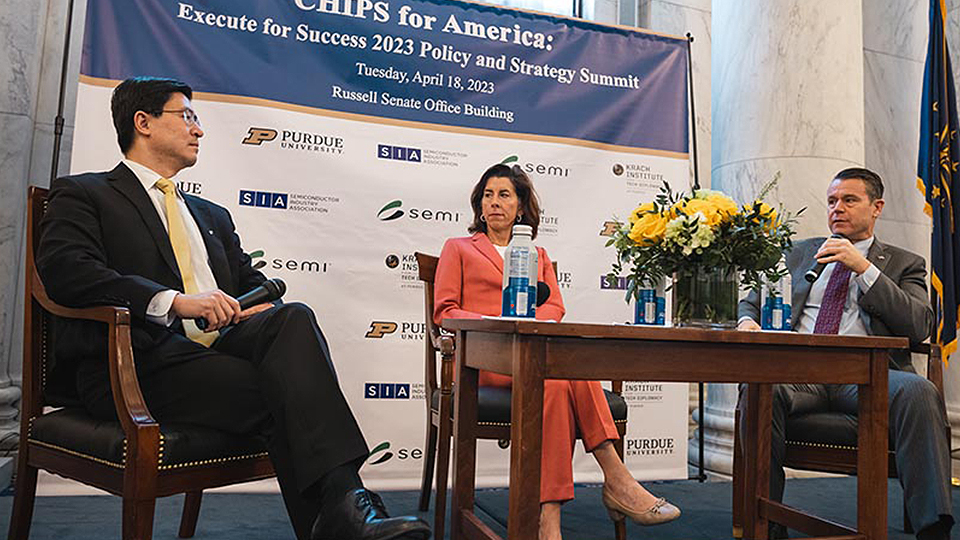Raimondo touts Purdue’s efforts to build semiconductor workforce
Subscriber Benefit
As a subscriber you can listen to articles at work, in the car, or while you work out. Subscribe Now
U.S. Secretary of Commerce Gina Raimondo believes Purdue University is doing exactly what needs to be done in order to build a pipeline of workers in the country’s growing semiconductor industry.
Raimondo participated in a panel discussion Tuesday led by Purdue President Mung Chiang, which included Senator Todd Young (R-IN), during the CHIPS for America: Execute for Success Summit in Washington D.C.
The summit coincided with the release of the CHIPS for America: Vision for Success plan, which outlines plans for the first investments to be made through the CHIPS and Science Act signed into law last year.
During the panel, Raimondo said she was blown away by what she saw during her visit to Purdue last September, and that more universities can benefit from Purdue’s model.
“The answer to your question of how do we do this is more people need to continue to do what Purdue is doing [by] allowing students class credit for applied work at companies, allowing companies to come into the universities, making sure that the students are job ready the day they graduate,” she said.
Raimondo said she hears from many employers who note that even graduates with engineering degrees from the top universities aren’t quite job ready because they’ve been taught on older versions of equipment or software.
She added the country needs to identify additional pipelines of workers as well.
“The forecasts are that we’ll be about 100,000 semiconductor technicians short in the next handful of years if we don’t do something differently,” she said. “That’s a huge problem; it’s also an opportunity. So we have to find students in high school, in other industries, men and women, people with college degrees and not, low-income folks, train them and place them in these jobs.”
Senator Young there is a lot of excitement in the air about what’s to come following Raimondo’s visit to Purdue, which also included Secretary of State Antony Blinken.
“What I’ve been encouraged about on the back end of that gathering is that our state has really operationalized many of the opportunities,” Young said. “We’re putting together a tech hub package. Purdue University and some other institutions are developing new workforce training programs for these key sectors. Indiana is really poised to play a (significant) role as it relates to semiconductors but also any of the other emerging technologies that we need to invest in.”
Purdue has been in the semiconductor spotlight even before the CHIPS and Science Act was signed into law by President Biden.
In June, Taiwan-based chip maker MediaTek detailed plans to establish a chip design center at the Convergence Center for Innovation and Collaboration in Purdue’s Discovery Park District. The following month, Minnesota-based SkyWater Technology (Nasdaq: SKYT) said it would invest $1.8 billion to build a semiconductor R&D and production facility at Purdue and create more than 750 jobs.
Last November, officials broke ground on an $84 million semiconductor campus at the WestGate@Crane Technology Park in Odon that has already attracted $300 million in investment.
Additionally, the university announced last week that is investing $100 million in semiconductor facilities as part of the new Purdue Computes initiative. The first phase, totaling $49 million, will be used for upgrades and equipment procurement for the Birck Nanotechnology Center.
The upgrades include new equipment for device fabrication and dedicated cleanroom and lab space for students.
“Birck Nanotechnology Center has for decades been a critical home for discovery and technology development, both for Purdue researchers and those from industry and other universities who use our facilities,” center Director Zhihong Chen said. “This investment will ensure that we maintain our state-of-the-art facilities, reclaim more space, and establish new capabilities for semiconductor R&D.”
The second phase, totaling $51 million, will be used to create an open innovation ecosystem, Purdue said. The effort is slated for completion in summer 2024.
Also during the CHIPS panel, Chiang announced the creation of the Sustainability Capability for Semiconductors Index, or SCSI, which involves industry partnerships that will provide quarterly reports that track the research in sustainability among five dimensions: water, power, construction, chemicals and emissions.
Chiang said details on the metrics and methodology of the tracking effort in the next few months.
